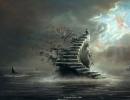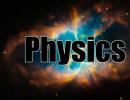The field and lines of force exist in reality. Field lines are the most interesting thing in blogs. What can be determined using Coulomb's law
« Physics - 10th grade"
What is the mediator that carries out the interaction of charges?
How to determine which of the two fields is stronger? Suggest ways to compare fields.
Tension electric field.
An electric field is detected by the forces acting on a charge. It can be argued that we know everything we need about the field if we know the force acting on any charge at any point in the field. Therefore, it is necessary to introduce a characteristic of the field, knowledge of which will allow us to determine this force.
If you alternately place small charged bodies at the same point in the field and measure the forces, you will find that the force acting on the charge from the field is directly proportional to this charge. Indeed, let the field be created by a point charge q 1. According to Coulomb's law (14.2), a point charge q is acted upon by a force proportional to the charge q. Therefore, the ratio of the force acting on the object placed in this point field charge, to this charge for each point of the field does not depend on the charge and can be considered as a characteristic of the field.
The ratio of the force acting on a point charge placed at a given point in the field to this charge is called electric field strength.
Like force, field strength is vector quantity; it is denoted by the letter:
Hence the force acting on charge q from the electric field is equal to:
Q. (14.8) 
The direction of the vector coincides with the direction of the force acting on the positive charge and is opposite to the direction of the force acting on the negative charge.
The unit of tension in SI is N/Cl.
Electric field lines.
The electric field does not affect the senses. We don't see him. However, we can get some idea of the field distribution if we draw field strength vectors at several points in space (Fig. 14.9a). The picture will be more clear if you draw continuous lines.

Lines whose tangent at each point coincides with the electric field strength vector are called power lines or field strength lines(Fig. 14.9, b).

The direction of the field lines allows us to determine the direction of the intensity vector at different points of the field, and the density (number of lines per unit area) of the field lines shows where the field strength is greater. So, in Figures 14 10-14.13 the density of field lines at points A is greater than at points B. Obviously, A > B.
One should not think that tension lines actually exist like stretched elastic threads or cords, as Faraday himself assumed. Tension lines only help to visualize the distribution of the field in space. They are no more real than the meridians and parallels on the globe.
Field lines can be made visible. If elongated crystals of an insulator (for example, quinine) are mixed well in a viscous liquid (for example, castor oil) and charged bodies are placed there, then near these bodies the crystals will line up in chains along the lines of tension.
The figures show examples of tension lines: a positively charged ball (see Fig. 14.10), two oppositely charged balls (see Fig. 14.11), two similarly charged balls (see Fig. 14.12), two plates whose charges are equal in magnitude and opposite in sign (see Fig. 14.13). The last example is especially important.
Figure 14.13 shows that in the space between the plates the lines of force are basically parallel and at equal distances from each other: the electric field here is the same at all points.
An electric field whose strength is the same at all points is called homogeneous.
In a limited region of space, the electric field can be considered approximately uniform if the field strength within this region changes slightly.
The electric field lines are not closed; they begin on positive charges and end on negative ones. The lines of force are continuous and do not intersect, since intersection would mean the absence of a specific direction of the electric field strength at a given point.
Electric field potential. Equipotential surfaces.
Conductors and dielectrics in an electric field.
Electrical capacity. Units of electrical capacity. Flat
Capacitor.
Electric field. Coulomb's law.
Electric field strength.
Field lines.
According to modern scientific ideas, matter exists in two forms: in the form of matter and in the form of field. There aren't many fields in nature. There are only these fields:
A) gravitational
B) electric
B) magnetic
D) nuclear
D) field of weak interactions.
And there are no more fields in nature and cannot be.
All information about other types of fields (biological, torsion, etc.) is false, although supporters of these fields try to subsume some kind of “scientific” theory under these concepts of non-existent fields, but as soon as the principle of presumption of provability is used, these pseudoscientific theories are completely rejected collapse. This should be taken into account by all medical specialists, since supporters of pseudoscientific theories brazenly speculate on the concepts of non-existent fields: they sell for a lot of money all sorts of useless devices that supposedly cure all diseases by the method of “correcting the biofield or torsion field.” All kinds of “torsion field generators”, “charged” amulets and other completely useless items are sold. And only solid knowledge of physics and others natural sciences will allow us to cut the ground from under the feet of those who profit from deceiving the population.
In this lecture we will look at one of the real fields - electric field.
As is known, the field does not affect our senses, does not produce sensations, but nevertheless, it really exists and can be detected by appropriate devices.
How does it manifest itself?
More in ancient Greece It was discovered that amber, rubbed with wool, began to attract various small objects: specks, straws, dry leaves. If you rub a plastic comb on clean and dry hair, it will begin to attract hair. Why did the hair not attract before rubbing against the comb, but after friction began to attract? Yes, after rubbing, a charge appeared on the comb after rubbing. And he was named electric charge. But why was there no charge before friction? Where did it come from after friction? Yes, a field exists around all bodies that have an electric charge. Through this field, the interaction between objects located at a certain distance is transmitted.
Further research showed that electrically charged bodies can not only attract, but also repel. From this it was concluded that there are two types of electric charges. They were conventionally called positive (+) And negative (-). But these designations are purely conventional. They could just as easily be called, say, black and white, or upper and lower, etc.
Like charges repel, and unlike charges attract. The unit of electric charge in the international system of SI units is pendant (Cl). This unit is named after the French scientist C. Coulomb. This scientist experimentally derived the law that bears his name:
F = k( q1q2)
F – force of attraction or repulsion between charges
q1 And q2 – charge values
R – distance between charges
k – proportionality coefficient is equal to 9*10 9 Nm 2 / Cl 2
Is there a smallest charge? It turns out yes, it exists. There is such elementary particle, the charge of which is the smallest and less than which does not exist in nature. At least according to modern data. This particle is electron. This particle is located in the atom, but not in its center, but moves in orbit around atomic nucleus. The electron has negative charge and its magnitude is q = e = -1.6*10 -19 Cl. This quantity is called elementary electric charge.
We now know what an electric field is. Now let’s consider the question: in what units should it be measured so that this unit is objective?
It turns out that the electric field has two characteristics. One of them is called tension.
To understand this unit, let's take a charge of +1 C and place it at one of the points of the field and measure the force with which the field acts on this charge. And the magnitude of this charge will be the field strength.
But, in principle, it is not necessary to take a charge of 1 C. You can take an arbitrary charge, but in this case the voltage will need to be calculated using the formula:
Here E– electric field strength. Dimension – N/C.
One of Faraday's most important achievements was his new interpretation of how force is transferred from one body to another. Instead of acting at a distance, he imagined lines of force running through space. During the 1830s and 1840s, Faraday continued to develop his idea of magnetic and electrical lines of force. But since this new idea did not have a mathematical form, most scientists rejected it. However, there were two important exceptions - William Thomson and James Clerk Maxwell.
Thomson gave Faraday's lines of force a mathematical interpretation and showed that the concept of lines of force was consistent with heat theory and mechanics; Thus, the mathematical foundation of field theory was laid. Faraday recognized the importance of the support of these "two very talented gentlemen and outstanding mathematicians"; he said: “for me it is a source of great pleasure and encouragement to feel that they confirm the justice and universality of the idea I have proposed.”
For Faraday, the idea of lines of force followed naturally from his experiments with magnets. When he dropped needle-shaped iron filings onto a piece of paper lying on a piece of magnet, he noticed that the filings lined up in lines going in a certain direction, depending on their position relative to the magnet.

He thought that magnetic poles connected by magnetic lines and that these lines are made visible by iron filings which are aligned parallel to the lines. For Faraday, these lines were real, although invisible. Faraday extended his idea of lines of force to electric forces; he believed that gravity could be interpreted in a similar way. Instead of arguing that the planet somehow knows how it should orbit the sun, Faraday introduced the concept of a gravitational field that controls the planet in orbit. The sun generates a field around itself, and the planets and others celestial bodies sense the influence of the field and behave accordingly. In the same way, charged bodies generate electric fields around themselves, and other charged bodies sense this field and react to it. There are also magnetic fields associated with magnets.
Newton believed that fundamental objects are particles bound together by forces; and the space between them is empty. Faraday imagined both particles and fields interacting with each other; and this is a completely modern point of view. It cannot be said that particles are more real than fields. We usually depict fields as lines indicating the direction of force at each point in space.
The denser the lines are, the greater the strength. Let's take the gravity of the Sun as an example. We can say that, coming from all possible directions, all lines of force end at the Sun. We can draw spheres of different radii centered on the Sun, with each field line intersecting each sphere. The area of the spheres increases as the square of their radius, so the density of the lines decreases in inverse proportion to the square of the distances.
Thus, the idea of lines of force leads us directly to Newton's law of gravity (and also to Coulomb's inverse square law for the electric field of a constant charge;  When using the idea of a force field (such as a gravitational field), you need to follow a few simple rules.
When using the idea of a force field (such as a gravitational field), you need to follow a few simple rules.
1. Gravitational acceleration occurs along a force field passing through the body.
2. The magnitude of the acceleration is proportional to the density of lines at a given point.
3. Lines of force can only end where there is mass. The number of lines ending at a given point is proportional to the mass of this point.
Now it is easy to prove a statement that Newton had to work hard on. Comparing accelerations on the surface of the Earth and in the orbit of the Moon, Newton assumed that the Earth acts on all bodies as if all its mass were concentrated at its center. Why?
Let's assume for simplicity that the Earth is perfectly round and symmetrical. Then all parts of its surface will be equally covered with incoming lines of force. According to the third rule, the number of field lines depends on the mass of the Earth. If all the mass were concentrated at the center of the planet, all these lines would continue to the center. Thus, the Earth's gravitational field
does not depend on how the mass is distributed under its surface if there is spherical symmetry. In particular, the entire mass of the Earth, concentrated at its center, creates exactly the same gravity as the real Earth.
Exactly the same reasoning applies to the electric field. But since there are two types of electric charge, positive and negative, then when the sign of the charge changes, the direction of the lines of force changes to the opposite. Lines of force begin at positive charge and end at the negative.
Topic 1.1 Characteristics and parameters of the electric field
Introduction to the discipline (main content of the discipline, dignity and role electrical energy, sources of electrical energy, use of electrical energy, electrification of the national economy, its significance, Lenin’s GOELRO plan, formation and initial development electrical engineering).
The concept of electric field. The main characteristics of the electric field: intensity, potential and electrical voltage. Coulomb's law.
Guidelines for studying topic 1.1
In the introduction, it is necessary to have an idea about the subject of “Electrical engineering and electronics” and its place in the national economy, about the importance of electrical engineering in the development of modern industry. Literature: pp. 5-6. And also have an understanding of the electric field and its main characteristics. Know Coulomb's law. References: Chapter 1, pp. 8-28.
Self-test questions
1. What renewable and non-renewable energy sources do you know?
2. What types of energy do the electrical receivers in your home convert electrical energy into?
3. What measures are used and which can be applied in your home to save energy?
4. Are there any advantages to transmitting electrical energy using direct current compared to transmitting it using alternating current?
5. What are the applications electrical devices DC?
6. The figure shows a model of the hydrogen atom. In what region of space does the electric field operate?
a) in the area
b) in area B?
7. Which of the following statements do you think is correct?
a) the field and lines of force exist in reality;
b) the field exists really, and the lines of force are conditional;
c) the field and lines of force exist conditionally.
8. What is the magnitude of the electric field potential?
a) vector; b) scalar.
Topic 1.2 Properties of conductors, semiconductors and electrical insulating materials
Conductors and dielectrics in an electric field. Electrical insulating materials and their properties. Electrical capacity. Capacitors. Capacitor connections. Varnishes and insulating materials for electrical installation work.
Guidelines for studying topic 1.2
Have an understanding of conductors and dielectrics in an electric field, electrical insulating materials and their properties. What is a capacitor? A unit of measurement for electrical capacitance. In what ways can capacitors be connected? What varnishes and insulating materials are used for electrical installation work.
Self-test questions
1. When connecting three capacitors in parallel connected to a power source, one of them (C 3) turned out to be broken. How will the voltage on the capacitors change and what will their total capacity be?
a) U = const; C total = C 1 + C 2;
b) U = 0; With total = ¥.
2. Three capacitors connected to the power source are connected in series. How will the voltage be distributed across the capacitors?
a) U 1 > U 2 > U 3;
b) U 3 > U 2 > U 1 ;
c) there is not enough data to answer the question.
3. Three capacitors can be connected in series, parallel or mixed connection circuits. How many connection circuits can be built from three capacitors of the same capacitance C and which of them has the smallest equivalent capacitance?
Section 2. MAGNETIC FIELD
Topic 2.1 Characteristics and parameters magnetic field
General information about the magnetic field. Basic properties and characteristics of the magnetic field. Force action of a magnetic field. Ampere's law, Lenz. Inductance.
Guidelines for studying topic 2.1
Have an understanding of the magnetic field, its properties and characteristics. What force does a magnetic field exert? Know the law of Ampere, Lenz, the concept of inductance and its units of measurement.
Self-test questions
1. What field arises around moving electric charges?
a) magnetic;
b) electric;
c) electromagnetic.
a) B = 200 Wb;
b) V = 0.25 × 10 -3 Wb.
3. What characteristic of the magnetic field does the henry per meter (G/m) correspond to?
4. How big is it? magnetic flux F?
a) vector;
b) scalar.
5. What is the value of magnetic voltage U m?
a) vector;






